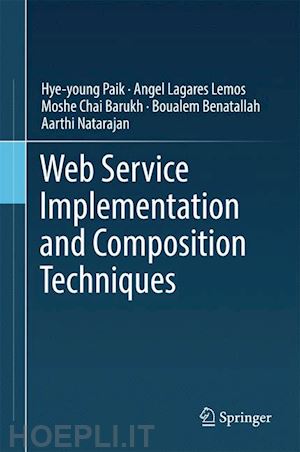

Questo prodotto usufruisce delle SPEDIZIONI GRATIS
selezionando l'opzione Corriere Veloce in fase di ordine.
Pagabile anche con Carta della cultura giovani e del merito, 18App Bonus Cultura e Carta del Docente
This book embarks on a mission to dissect, unravel and demystify the concepts of Web services, including their implementation and composition techniques. It provides a comprehensive perspective on the fundamentals of implementation standards and strategies for Web services (in the first half of the book), while also presenting composition techniques for leveraging existing services to create larger ones (in the second half). Pursuing a unique approach, it begins with a sound overview of concepts, followed by a targeted technical discussion that is in turn linked to practical exercises for hands-on learning. For each chapter, practical exercises are available on Github.
Mainly intended as a comprehensive textbook on the implementation and composition of Web services, it also offers a useful reference guide for academics and practitioners. Lecturers will find this book useful for a variety of courses, from undergraduate courses on the foundational technology of Web services through graduate courses on complex Web service composition. Students and researchers entering the field will benefit from the combination of a broad technical overview with practical self-guided exercises. Lastly, professionals will gain a well-informed grasp of how to synthesize the concepts of conventional and “newer” breeds of Web services, which they can use to revise foundational concepts or for practical implementation tasks.
1 Introduction to Service Oriented Architecture.- 2 Web Services - SOAP and WSDL.- 3 Web Services - REST or Restful Services.- 4 Web Services - Data Services.- 5 Web Service Composition: Overview.- 6 Web Service Composition: Control Flows.- 7 Web Service Composition: Data Flows.- 8 Service Component Architecture (SCA).- 9 Conclusion.- References.- Index.
Hye-young Paik is a Senior Lecturer in the School of Computer Science and Engineering at the University of New South Wales (UNSW), Sydney, Australia. She has been teaching and researching the topics related to Web services and Business Process Management for many years. Her current research interests include flexible Web service composition, personalizing business processes and text mining techniques for business processes.
Angel Lagares Lemos is the COO of Nimbeo and a Post-Doctoral Researcher at the Department of Computer Science, Carlos III University, working with the IBIS group. He obtained his PhD in Computer Science and Engineering at UNSW Australia, for his work on unlocking Web service composition. His current research interests include Web service composition, semantic Web, semantic Web services, business process modeling, Software-as-a-Service (SaaS) and cloud computing.
Moshe Chai Barukh is a Lecturer & Senior Research Fellow inthe Service Oriented Computing Research Group at UNSW Australia. He obtained his PhD in Computer Science and Engineering at UNSW, for his work on effective techniques for Service Oriented Programming and management of Hybrid Processes. His primary research interests include Web services integration and composition techniques, agile business process management, big data analytics, cloud and social computing.
Boualem Benatallah is a Scientia Professor in the School of Computer Science and Engineering at UNSW Australia; the founder and leader of the Service Oriented Computing Research Group at UNSW. His research interests include Web services composition, quality control in crowdsourcing services, cloud services orchestration, data curation and end users analytics.
Aarthi Natarajan is an academic and software consultant with over 18 years of professional experience; she is currently engaged as a professional instructor at UNSW Australia and Oracle University. She obtained her PhD in Computer Science and Engineering at UNSW for her work on a model-driven architecture for conducting event data analysis. Her current research interests include big data/financial analytics, business process modeling and semantic technologies.











Il sito utilizza cookie ed altri strumenti di tracciamento che raccolgono informazioni dal dispositivo dell’utente. Oltre ai cookie tecnici ed analitici aggregati, strettamente necessari per il funzionamento di questo sito web, previo consenso dell’utente possono essere installati cookie di profilazione e marketing e cookie dei social media. Cliccando su “Accetto tutti i cookie” saranno attivate tutte le categorie di cookie. Per accettare solo deterninate categorie di cookie, cliccare invece su “Impostazioni cookie”. Chiudendo il banner o continuando a navigare saranno installati solo cookie tecnici. Per maggiori dettagli, consultare la Cookie Policy.